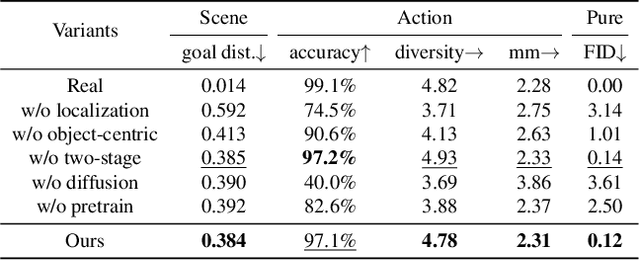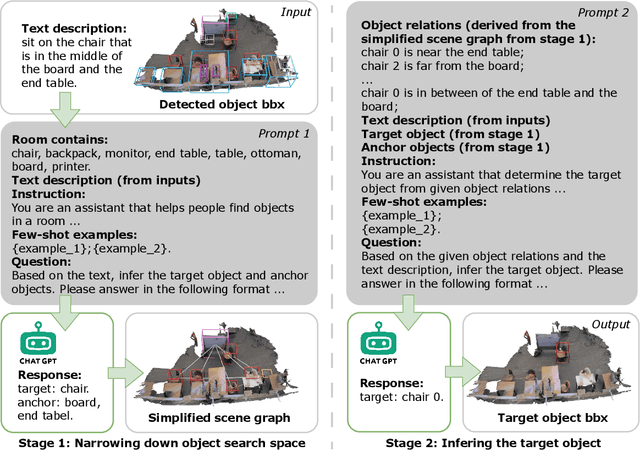Zhi Cen
Ready-to-React: Online Reaction Policy for Two-Character Interaction Generation
Feb 27, 2025Abstract:This paper addresses the task of generating two-character online interactions. Previously, two main settings existed for two-character interaction generation: (1) generating one's motions based on the counterpart's complete motion sequence, and (2) jointly generating two-character motions based on specific conditions. We argue that these settings fail to model the process of real-life two-character interactions, where humans will react to their counterparts in real time and act as independent individuals. In contrast, we propose an online reaction policy, called Ready-to-React, to generate the next character pose based on past observed motions. Each character has its own reaction policy as its "brain", enabling them to interact like real humans in a streaming manner. Our policy is implemented by incorporating a diffusion head into an auto-regressive model, which can dynamically respond to the counterpart's motions while effectively mitigating the error accumulation throughout the generation process. We conduct comprehensive experiments using the challenging boxing task. Experimental results demonstrate that our method outperforms existing baselines and can generate extended motion sequences. Additionally, we show that our approach can be controlled by sparse signals, making it well-suited for VR and other online interactive environments.
World-Grounded Human Motion Recovery via Gravity-View Coordinates
Sep 10, 2024



Abstract:We present a novel method for recovering world-grounded human motion from monocular video. The main challenge lies in the ambiguity of defining the world coordinate system, which varies between sequences. Previous approaches attempt to alleviate this issue by predicting relative motion in an autoregressive manner, but are prone to accumulating errors. Instead, we propose estimating human poses in a novel Gravity-View (GV) coordinate system, which is defined by the world gravity and the camera view direction. The proposed GV system is naturally gravity-aligned and uniquely defined for each video frame, largely reducing the ambiguity of learning image-pose mapping. The estimated poses can be transformed back to the world coordinate system using camera rotations, forming a global motion sequence. Additionally, the per-frame estimation avoids error accumulation in the autoregressive methods. Experiments on in-the-wild benchmarks demonstrate that our method recovers more realistic motion in both the camera space and world-grounded settings, outperforming state-of-the-art methods in both accuracy and speed. The code is available at https://zju3dv.github.io/gvhmr/.
Generating Human Motion in 3D Scenes from Text Descriptions
May 13, 2024



Abstract:Generating human motions from textual descriptions has gained growing research interest due to its wide range of applications. However, only a few works consider human-scene interactions together with text conditions, which is crucial for visual and physical realism. This paper focuses on the task of generating human motions in 3D indoor scenes given text descriptions of the human-scene interactions. This task presents challenges due to the multi-modality nature of text, scene, and motion, as well as the need for spatial reasoning. To address these challenges, we propose a new approach that decomposes the complex problem into two more manageable sub-problems: (1) language grounding of the target object and (2) object-centric motion generation. For language grounding of the target object, we leverage the power of large language models. For motion generation, we design an object-centric scene representation for the generative model to focus on the target object, thereby reducing the scene complexity and facilitating the modeling of the relationship between human motions and the object. Experiments demonstrate the better motion quality of our approach compared to baselines and validate our design choices.
Learning Human Mesh Recovery in 3D Scenes
Jun 06, 2023Abstract:We present a novel method for recovering the absolute pose and shape of a human in a pre-scanned scene given a single image. Unlike previous methods that perform sceneaware mesh optimization, we propose to first estimate absolute position and dense scene contacts with a sparse 3D CNN, and later enhance a pretrained human mesh recovery network by cross-attention with the derived 3D scene cues. Joint learning on images and scene geometry enables our method to reduce the ambiguity caused by depth and occlusion, resulting in more reasonable global postures and contacts. Encoding scene-aware cues in the network also allows the proposed method to be optimization-free, and opens up the opportunity for real-time applications. The experiments show that the proposed network is capable of recovering accurate and physically-plausible meshes by a single forward pass and outperforms state-of-the-art methods in terms of both accuracy and speed.
 Add to Chrome
Add to Chrome Add to Firefox
Add to Firefox Add to Edge
Add to Edge